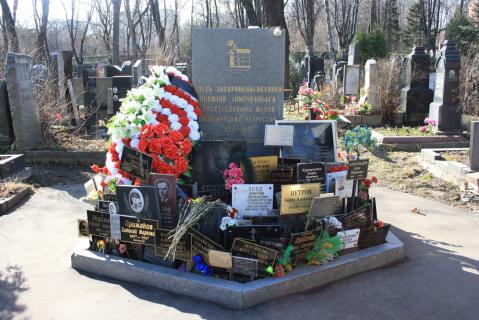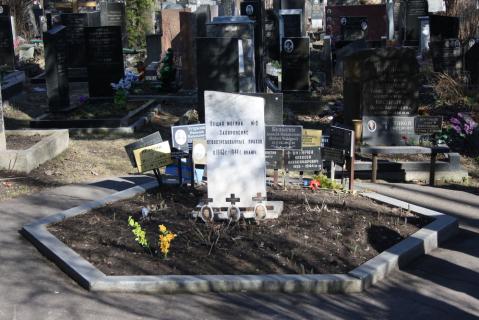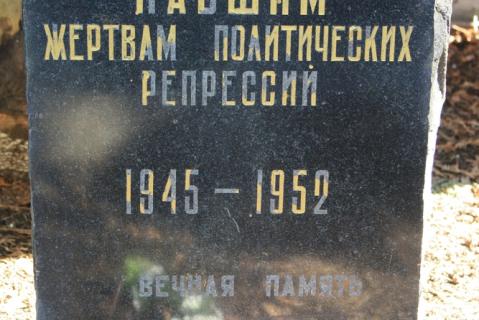From 1935 until the early 1950s the bodies of those shot in Moscow prisons were cremated at the former Donskoe Monastery and, from time to time (mainly in 1937), some were interred there as well. The burials took place next to the crematorium. The cremated remains were buried in common pits and were referred to as “burials of uncollected ashes”. In the northern part of the graveyard there are three such burials: the first is dated “1932 to 1940 incl.”, the second “from 1943 to 1944 incl.” and the third “1945-1989”.
In August 1991 a granite plaque was placed on “Common Grave No. 1”. It reads, “Here lie the remains of the innocent tortured and executed victims of political repression, 1930-1942. May they never be forgotten!” In 1994 a pillar was placed on “Common Grave No. 3” with the inscription, “To those who fell victim of political repression, 1945-1952. May they never be forgotten!” Subsequently a great many collective and personal memorials, large and small, appeared in the graveyard. In the “Execution lists” of the Donskoe Monastery published by the Memorial Society in 1995 there are brief biographical notes on 5,068 people.
A ten-volume Book of Remembrance was published for the city of Moscow and its victims: one each for the Vagankovskoe Cemetery (1995), the Kommunarka “special site” (2000) and the Donskoe Monastery (2005); and seven volumes for the Butovo Firing Range (1997-2003). Together they provided biographical entries on 31,900 who were shot or sent to the camps; this total included brief notes on 5,590 victims of political repression who had not been formally rehabilitated.
The Memorial online database (2025) includes 22,429 victims in the city of Moscow (and 20,527 buried at Butovo).
11,253 were shot. Most were executed during the Great Terror (8,252), but almost two thousand more were shot (1,788) in 1939-1942. Cases against 254 other individuals were closed, most in the 1930s and 1950s: 15 of them died in captivity. (The documentation of the city procurator’s office covering more than 19,000 cases is also included in the database: cases were closed against 4,000 individuals, 306 of whom died in captivity: over half were not Moscow residents when arrested.)
More than 6,000 were sent to the camps. Families and individuals (total 3,533) were deported from the city from the 1920s onwards, over a thousand in the 1930s. 753 are recorded as dying in the camps or in exile.
5,063 of those shot are cited from the 2005 Moscow execution lists (1935-1953): Donskoe Graveyard. The database indicates that 3,477 of them were shot during the Great Terror.
| Date | Nature of ceremonies | Organiser or responsible person | Participants | Frequency |
|---|---|---|---|---|
|
30 October
|
Solemn ceremonies to mark Remembrance Day for the Victims of Political Repression
|
nk
|
Public figures, relatives of the victims, officials
|
Annual event
|
|
Solemn ceremonies at the symbolic headstones
|
nk
|
Official delegations, Russian and foreign, public organisations and private individuals
|
From time to time
|
| State of burials | Area | Boundaries |
|---|---|---|
|
Burials preserved
|
Memorial area
|
defined
|
[ original texts and hyperlinks ]
Lists of those shot in Moscow 1937-1952: The Donskoe cemetery [crematorium], A Book in Remembrance of the Victims of Political Repression (edited and compiled by Seleznyov, Yeremina, and Roginsky), Memorial: Moscow, 2005 (596 pp)
“Burials at the Donskoe Cemetery, listed by year”, website of the International Memorial Society [retrieved, 17 January 2025]
“Novoe Donskoe graveyard. Burials / cremations of the executed”, Virtual Museum of the Gulag [partially retrieved, 3 June 2022; no longer accessible]



